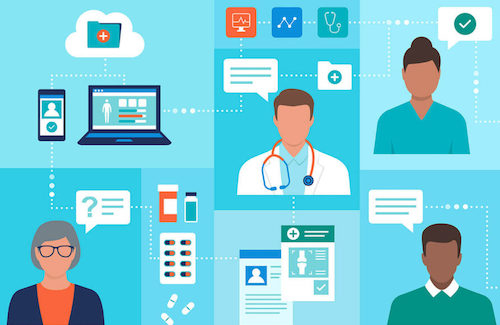The Internet of Medical Things (IoMT) is a transformative technology that has revolutionized the healthcare industry. By integrating medical devices and wearables with the internet and healthcare systems, IoMT enables seamless data exchange and real-time communication between devices, healthcare professionals, and patients. This article provides a comprehensive overview of how IoMT works, its key components, benefits, and challenges.
Understanding IoMT
IoMT is an extension of the broader Internet of Things (IoT) concept, which involves connecting everyday objects to the internet for data sharing and automation. In the context of healthcare, IoMT encompasses medical devices, wearables, sensors, and other equipment that collect and transmit health-related data to connected systems.
The core principle of IoMT is the interconnectivity of medical devices with healthcare apps and platforms, allowing data to flow securely and efficiently between them. This enables healthcare professionals to monitor patients’ health remotely, make data-driven decisions, and provide personalized care.
Key Components of IoMT
- Medical Devices and Wearables: The foundation of IoMT lies in medical devices and wearables equipped with sensors and communication capabilities. These devices can monitor various health parameters, such as heart rate, blood pressure, glucose levels, oxygen saturation, and activity levels. Common examples include smartwatches, fitness trackers, connected blood pressure monitors, and continuous glucose monitoring systems.
- Connectivity: IoMT relies on various communication technologies to establish connections between medical devices and healthcare systems. The choice of connectivity depends on factors like data transfer speed, range, power consumption, and security requirements.
- Cloud Infrastructure: The data generated by IoMT devices is typically sent to cloud-based servers for storage and processing. Cloud infrastructure offers scalability, accessibility, and computational power needed to handle the vast amounts of data generated by IoMT devices.
- Healthcare Apps and Platforms: IoMT is complemented by healthcare apps and platforms that receive, store, and analyze the data from connected devices. These apps enable patients to view their health metrics, set goals, and receive personalized insights. Healthcare professionals can access patient data remotely and make informed decisions based on real-time information.
- Data Security and Privacy: With sensitive medical data being transmitted, ensuring data security and privacy is paramount in IoMT. Implementing robust encryption, authentication protocols, and compliance with healthcare regulations are critical to safeguarding patient information.
How IoMT Works
- Data Collection: IoMT devices continuously collect health data from users. For example, a wearable fitness tracker records heart rate, sleep patterns, and physical activities, while a glucose monitor measures blood glucose levels for diabetic patients.
- Data Transmission: The collected data is transmitted securely from the IoMT device to the connected healthcare app or platform. Communication technologies like Bluetooth or Wi-Fi facilitate this data transfer.
- Data Processing and Storage: Once the data reaches the healthcare app or platform, it is processed and stored in the cloud infrastructure. Cloud servers store vast amounts of data and perform complex analytics to derive valuable insights.
- Data Analytics and AI: Data analytics and artificial intelligence play a crucial role in IoMT. AI algorithms analyze the collected data to identify patterns, detect anomalies, and make predictions about the user’s health. For instance, AI can detect irregular heart rhythms from ECG data or predict potential health risks based on a combination of health parameters.
- Patient Engagement: IoMT aims to promote patient engagement and empowerment. Healthcare apps and platforms provide users with access to their health data, personalized recommendations, and actionable insights. This encourages individuals to take proactive steps towards improving their well-being.
- Remote Monitoring: Healthcare professionals can remotely monitor patients’ health conditions through IoMT devices. For instance, doctors can track vital signs, glucose levels, or medication adherence without the patient needing to visit a clinic physically.
Benefits of IoMT
- Enhanced Patient Care: IoMT facilitates real-time monitoring of patients, leading to early detection of health issues and timely interventions. This proactive approach can significantly improve patient outcomes and reduce hospital readmissions.
- Remote Patient Management: IoMT enables remote patient monitoring, especially for patients with chronic conditions. Healthcare professionals can track patients’ progress, adjust treatment plans, and provide personalized care without the need for frequent in-person visits.
- Improved Efficiency and Productivity: IoMT streamlines healthcare processes by automating data collection and analysis. Healthcare professionals can access accurate patient data instantly, leading to better decision-making and more efficient care delivery.
- Personalized Healthcare: IoMT devices provide continuous data streams, allowing healthcare apps to offer personalized health insights and recommendations tailored to individual needs and conditions.


